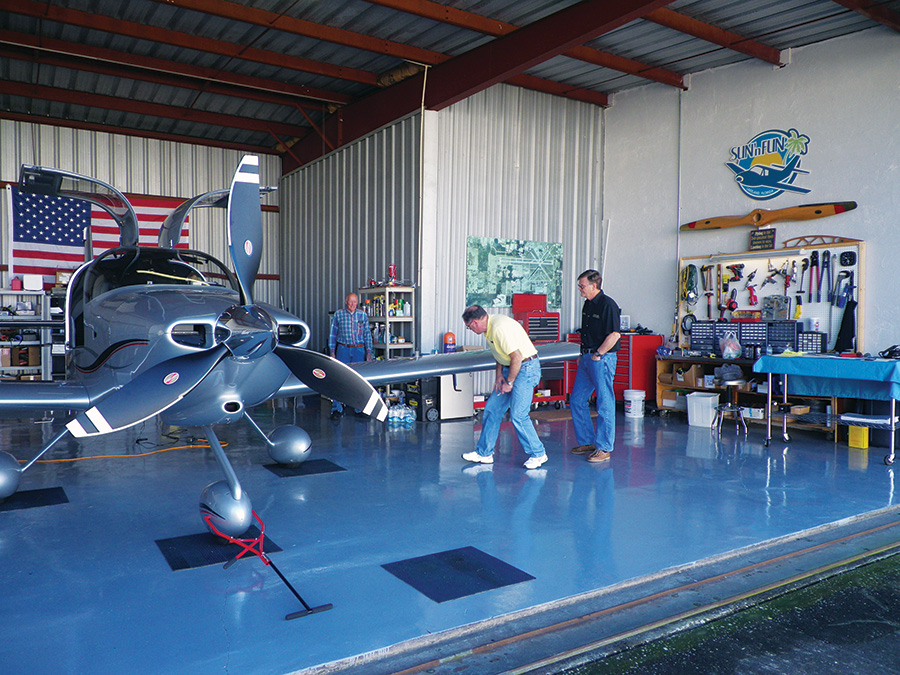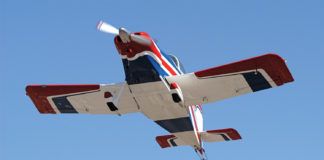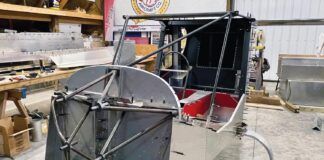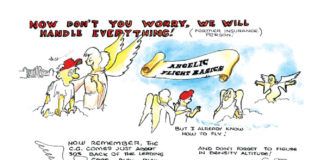Late in 2014 the FAA released Advisory Circular 90-116, which provides information and guidance on the Additional Pilot Program (APP) for flight testing Experimental aircraft during Phase I. Prior to this advisory circular, Phase I testing was limited to no more than one person in the cockpit, unless a second person was essential to the purpose of the flight.
The reality is that it is hard to justify a second person in the cockpit of a single-engine aircraft, especially since I am not aware of any U.S.-certified single-engine aircraft that requires a crew of two. Unfortunately, statistics show that most of the serious accidents of Amateur-Built aircraft occur during the initial eight hours of flight-testing, with over 20% occurring on the first flight, many due to engine failures and the subsequent loss of control.

Testing the stall warning horn. I didn’t expect it to be accurate on the first flight, but I sure wanted to know what kind of noise it would make if it activated.
Further analysis has shown that many of those are due to low-time-in-type pilots or non-proficient pilots. Many of us are also aware of builder/pilots who elected to ignore the rules and went ahead and flew with multiple pilots in the cockpit for maiden flights. Not all of those turned out so well.
I personally am not fond of the change to allow a second person in the cockpit during this very critical period. I have performed over 20 maiden flights myself, and coupled with over 1400 hours of instructing, I have a real understanding of how things can pile up very fast on an unsuspecting pilot. My opinion is that the cockpit of an Amateur-Built airplane’s first flight is not exactly the best place to be for an unsuspecting, non-proficient, low-time pilot.
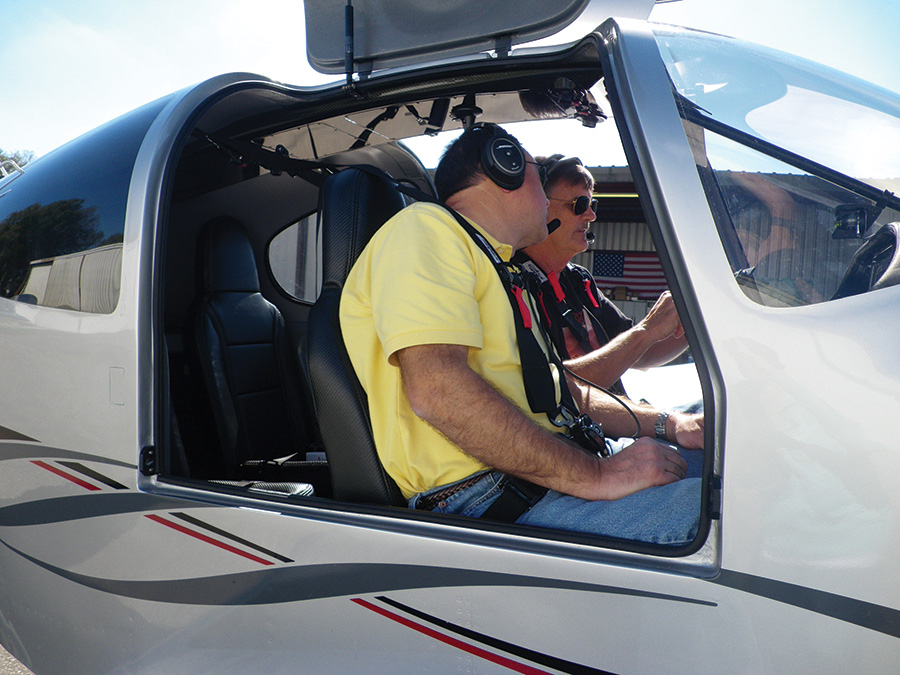
These were the final checks and briefing prior to engine start. I wanted us completely ready to go so as to minimize engine temps on the new engine. I like to make the first flight with a good margin on the temps when leaving the ground.
So why should we add another pilot into the equation? I can understand the drive of the builder to make that first flight. I have heard that not making it yourself would be kind of like sending your new wife on a honeymoon with someone else. I don’t know which one would have worse consequences, and I can only speak to the aviation side!
As a DAR, I started incorporating AC 90-116 into Phase I limitations as soon as it was permitted. As it turns out, I was presented with an opportunity that would test my opinion on this sooner than I thought.
Heading to Florida
It all started with a phone call I received the day that the Light Sport Expo opened in Sebring, Florida. I was supposed to be there myself, but the weather in Atlanta was not being cooperative. It was typical December and January weather with low ceilings and rain that persisted for days. And it was really low, way beyond my comfort zone—200 feet overcast and one-quarter-mile visibility over a large part of the Southeast.
I had committed to spending some time with Rob Hickman of AFS and Robert Hamilton of Dynon, now a single company. I had already texted Rob that I would not be able to make it on Wednesday, but Friday looked promising. Rob actually called back and said there was a gentleman at the show who claimed he had his RV-10 completed and was looking for a DAR. Rob had given him my number, and sure enough, he called while I was still speaking with Rob.
His name is Bob Beaty. Some of you may know Bob, as he is the vice-chairman of Sun ‘n Fun (SNF). I didn’t know Bob, and kind of wondered how I could not know of him, having been going to SNF since I first brought my RV-4 there in 1984. I was the first RV-4 to SNF, but that’s another story.
After spending time with Bob over the course of the next few days, I understand why I didn’t know him or of him. He is a commensurate gentleman, very low key, and actively involved in furthering aviation in education. Bob is also recently retired, and like most of us who are addicted to aviation, Bob’s career in pharmacy didn’t stop him from restoring a 1946 Aeronca Chief with three friends, or building a Kitfox Model 1200 Speedster, or building a GlaStar in his spare time. So it should be no surprise to you when you see Bob’s RV-10—Wow! will probably be the first thing that comes to mind. But I’m getting ahead of myself.
Back to the phone call from Bob—sure enough, he claimed he was finished and was ready for an inspection. We traded some emails and phone calls, and Bob went right back to the hotel to get the necessary paperwork in order. Within hours I had approval to perform Bob’s inspection, and we both agreed that Friday might work if the forecasts held out as promised. Normally I work with a builder weeks ahead of the inspection, and sometimes for much longer. This was going to be a record for sure.
Friday morning dawned clear and cold as promised. My wife Carol and I loaded the RV-10 and departed for Sebring, expecting to have lunch with Rob and Robert. Unfortunately, just as we were less than 15 minutes out, ATC informed us that the airport was closed due to an accident. So, we and everyone else approaching Sebring diverted to Avon Park Executive. For a while Avon Park looked like its own Light Sport Expo. From there I called Bob and told him we could get started on his inspection a little earlier if he was ready.
Lakeland, at Last
We quickly departed Avon and headed to Lakeland, Florida, where Bob was based. It was the first time in 30 years that I flew to Lakeland without flying the Lake Parker Arrival and landing on a colored dot. It may have even been the first time I got to land on the main runway! I made a comment to the tower to that effect when I was cleared to land from the right base, and we both chuckled.
So now I was finally meeting Bob for the first time, along with his good friend Roy Cook, whom I came to understand was a very large contributor in the build process. It turns out Roy, who is 80+ years, retired from Eastern Airlines after 31 years of service as an A&P. He happened to be the first to the scene of the Flight 401 L-1011 crash into the Everglades many years ago.
As we pulled up to Bob’s hangar, I couldn’t help but notice how beautiful Bob’s airplane looked, and I couldn’t wait to take a closer look. But it being lunchtime, we all decided to go get some food. I usually do the paperwork first, and get to know the builder. The answers to the questions, as well as the completeness of the paperwork, always give me some insight as to what to expect of the aircraft itself. Lunch would make this much easier, and it turns out this one was to be no exception.
Bob had purchased his empennage kit at SNF (no surprise there!) in 2012, and he started the build process in his shop in Franklin, North Carolina, where he lived at the time. He actually finished most of the construction there, and only recently moved it to Lakeland for the final assembly. Even though he has a home in both locations, he decided that Lakeland would be a much safer flight test area than the North Carolina mountains. I liked the way this guy thinks!
Bob even built and wired his own panel, using Advanced Flight Systems EFISes and the usual array of Garmin products in the center stack, anchored with a GTN 650. I asked my usual question inquiring if any modifications were made to the airplane. The only thing that came up was that Bob had installed a particular air-oil separator that has been proven to cause problems, including failure modes that necessitated emergency landings due to blown engine nose seals and subsequent loss of oil.
It turns out Bob had been so heads-down on building for the last few months that he missed all of the web traffic regarding this particular product. I also strongly suggested that I wouldn’t license the airplane with it currently installed. Bob couldn’t wait to get back to the hangar and remove it. Did I tell you I like the way this guy thinks and listens?
Inspection Time
Once we got back to the hangar and finished with the paperwork, I finally got to see the airplane. It was just as beautiful and meticulously built as I thought it would be. We found the usual assortment of things that needed to be remedied prior to the first flight, but nothing that was deemed unairworthy, so I was very proud to present Bob with his Special Airworthiness Certificate, as well as the Operating Limitations, which included the reference to AC 90-116.
It was then that we started discussing the first flight, and Bob brought up the subject of my willingness to participate using AC 90-116. Remember me noticing how this guy thinks? Yep, it was still showing. He recognized he was not exactly the right person to be making the first flight, and that he could use some help and guidance.
Bob was up to speed on the requirements of the AC, as was I. And while I am particular about the aircraft I agree to test fly, this was going to be new territory for me as well. And while I am both a seasoned instructor and an accomplished test pilot (Amateur-Built only), putting both of these together could make for some interesting times. I also have spent time as a first officer with a regional carrier, have received CRM training, and am typed for SIC duties in a CRJ. My experience and qualifications, along with getting to know Bob in the last few days, as well as seeing his airplane in person, gave me a high confidence factor for success. Having someone else in the cockpit on a maiden flight is not my first choice, but in this case I certainly couldn’t find a reason to say no.
Preparing for the First Flight
One of the last things I do after I license an airplane is to tell the builder-pilot to take his/her time putting the aircraft back together and then put the tools away and get into pilot mode. Spend some time in the cockpit doing some flying while on the ground. I don’t advocate making the test flight as soon as the DAR leaves. Small things can get overlooked in the rush to go flying. Bob agreed, and we both decided that we would look for a day in the coming week to get together and make the first flight. It would also give us some time to completely understand the details of the advisory circular and make certain we were compliant in all regards. It turns out there are a lot of requirements to be met in the advisory circular in order to take advantage of the two-pilot scenario.
So, Carol and I headed back to Sebring to see Rob and Robert for about an hour, and then headed back to Atlanta the following day. The next few days would have Bob and I communicating back and forth quite a bit regarding AC 90-116.
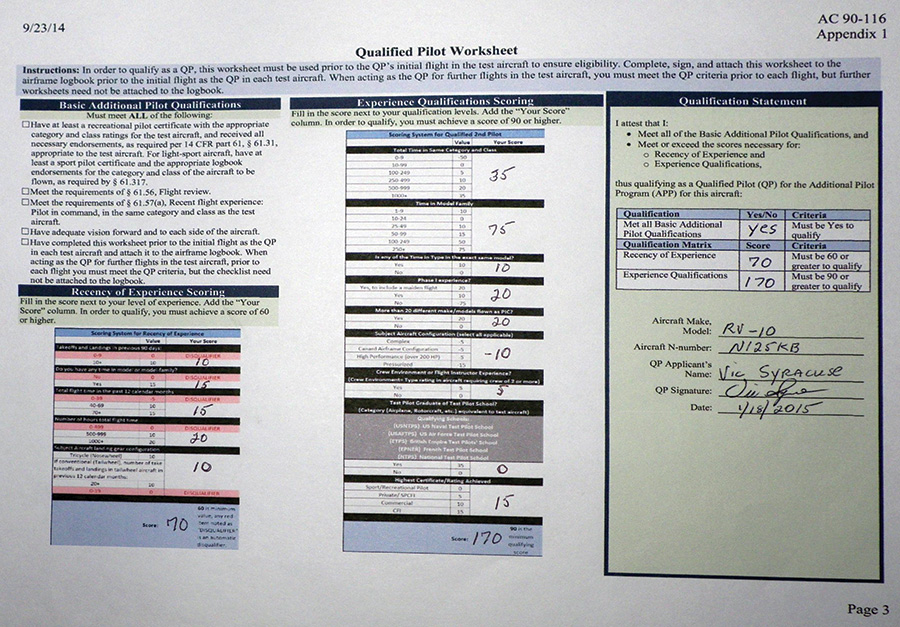
The AC is very clear as to the requirements of the Qualified Pilot. The worksheet must be filled out and attached to the logbook for the first flight.
AC Requirements
There are three primary areas one needs to pay attention to. In a nutshell, there are specific requirements for the aircraft, the engine, and the qualifications of the additional pilot.
The advisory circular is not a way to have your buddy who just test flew his first homebuilt help you fly yours. Additional pilot requirements fall into two separate categories, that of Qualified Pilot and Observer Pilot. The bar for Qualified Pilot is much higher, on both the pilot and the airplane, than it is for the Observer Pilot.
Qualified Pilots are primarily used for maiden flights and for at least the first eight hours of test flying, helping the Builder Pilot gain time and experience in the test aircraft while completing a specific set of maneuvers, including takeoffs, landings, stalls, steep turns, slow flight, simulated emergency approaches and landings, and more.

The AC has specified requirements for the Builder Pilot as well, and the worksheet must be attached to the logbook prior to the flight.
An Observer Pilot is not allowed on board until the test aircraft has at least eight hours of flight time and the Builder pilot has logged a minimum of eight hours in the test aircraft and has successfully performed all of the required maneuvers.
In Bob’s case there weren’t any issues with the airplane or engine. He had installed a Lycoming Thunderbolt engine of the appropriate horsepower as recommended by the kit manufacturer, as well as had completed the fuel flow tests and ground runs. Bob had also paid for extra test cell time for his engine, so we were pretty confident that the engine would run just fine. And Lakeland had a lot more runways available than during SNF, as well as lots of flat space surrounding the airport.
Only aircraft with engines recommended by the kit manufacturer (except turbine engines) can take advantage of AC 90-116 at this time. The aircraft must also have fully functioning dual controls. As an example, an RV-8 would be tough to meet the criteria, as most do not have a complete set of dual controls. And even an RV-7 with a Subaru engine would not make the cut, as it is not a recommended engine by Van’s. However, a Kitfox with a Rotax 912 would be allowed.
There are specific entries required in the logbooks and specific worksheets to be filled out for each pilot. I certainly met all of the Qualified Pilot requirements, maxing out everything except the Test Pilot School question. That dream went south in the fifth grade when I got sent home by the nurse with a note to go see the eye doctor. That was a long walk home I’ve never forgotten. Bob also filled out his worksheet and met all of the requirements, including the high-performance endorsement required for the RV-10.

Logbook entries must be made with the specifics of the flight. There are requirements for certain maneuvers and hours to be accomplished prior to the Builder Pilot having Observer Pilots on board during Phase I. Observer Pilots have less required qualifications than Qualified Pilots.
The Big Day
We had decided that Wednesday would be the day, so I headed down with a much better start than the prior week. Bob and Roy were ready upon my arrival, with the paperwork again all in order. We spent a good hour briefing the flight. This was Bob’s big day and I was there to ensure a safe and fun flight for him and his aircraft. We then proceeded to do a very thorough preflight and added some more fuel. Bob had already put the requested 50 pounds of ballast in the baggage compartment to give us a good CG for the flight.
Having decided all was ready with the pilots and the aircraft, we again briefed, with me reminding Bob that I would handle all radio communications and cockpit noises, and that he was to be solely focused on flying the aircraft. I have enough experience to know that with new airplanes and new glass cockpits with all of the bells and whistles, there would probably be a few nuisance alarms. My job was to not let him get distracted. We also agreed that in the event of an engine failure or anything requiring an immediate landing, I would assume control of the airplane and would firmly convey that message. My intent, barring any unforeseen problems, was to have Bob completely handle the controls for his first flight, with me only nudging if necessary. RV-10s are very docile, well-mannered airplanes, and I expected this one to be no different.
We climbed into the cockpit and got everything set up with all of the radios. My practice is to minimize ground time on the first flight to insure proper engine break-in once airborne. Bob had already briefed the tower on the event, and they were ready when I asked for an expedited taxi for a full-length departure that might include an abort. It was a fairly long taxi, and it gave us time to seat the brakes, let them cool in time for a runup, and then depart.
All was looking good as we rolled onto the runway, and Bob did a great job of tracking the centerline during the ground run and then climbing straight ahead until I advised him to begin a left turn. By the departure end of Runway 9, I had a pretty good sense that we were going to be OK, as we were almost 1000 feet in the air and all engine parameters and flight controls were normal, with cylinder head temps high, but normal for first flights. By the time we made our first 360, we were at 2500 feet and had reduced power to 75%. Cylinder head temps immediately started to fall, and I think I heard Bob take his first breath!
For the next few minutes, I kept Bob focused on holding altitude and staying within the confines of the airport traffic area, while I monitored the engine and got rid of some nuisance alarms. For the next 30 minutes, it was actually enjoyable watching Bob smiling and constantly saying, “Boy, this is fun!” I had briefed Bob that if all went well, we would perform a power-off stall at the 40-minute mark to check our airspeed and flaps in preparation for the final approach and landing. As expected the RV-10 performed flawlessly in this maneuver, the stall being very gentle. We then asked the tower to work us in, and Bob did an absolutely wonderful job of an approach and landing.
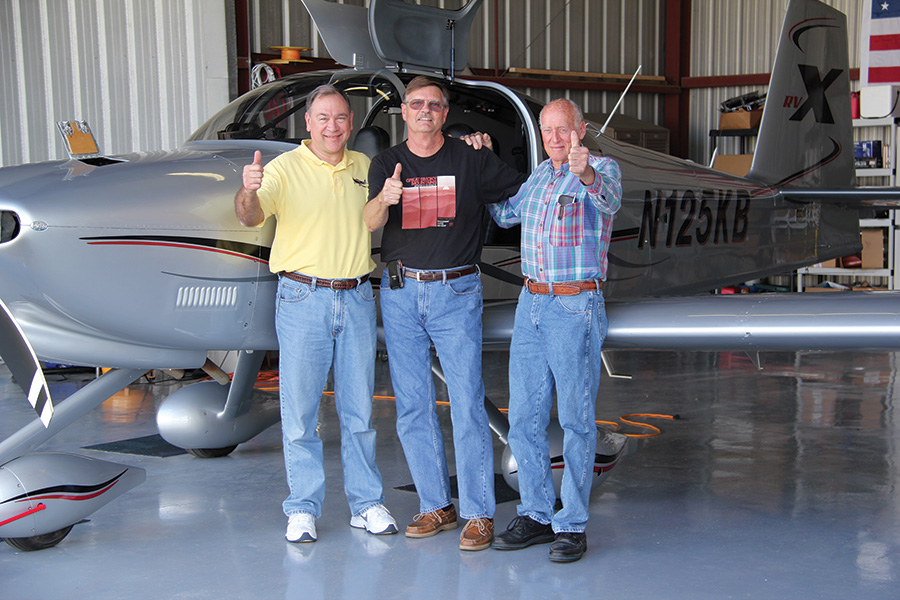
Bob (center) and Roy (right) with the author giving the thumbs up after a successful flight. Do you think we could get Bob to smile? First flights are stressful. Don’t let anyone tell you differently.
Once we landed, I again made some necessary configuration changes to the avionics, and we decided to make one more flight for the day. Again, Bob did a wonderful job, and the second flight was just as uneventful as the first. We post-briefed and Bob agreed that it would still be best if he had another Qualified Pilot on board for a few more flights, but we both agreed that it was best to call it quits for the day. First flights can be very stressful, especially for inexperienced builder-pilots, even when things all go well.
Lessons Learned
So, what have I gained from this experience? First, I met a really competent builder and genuine person that I am glad to know. I also have a different view of the Advisory Circular. While I still believe there shouldn’t be two people in the cockpit on the first flight, I have come to an understanding that in some cases, it can be safely utilized.
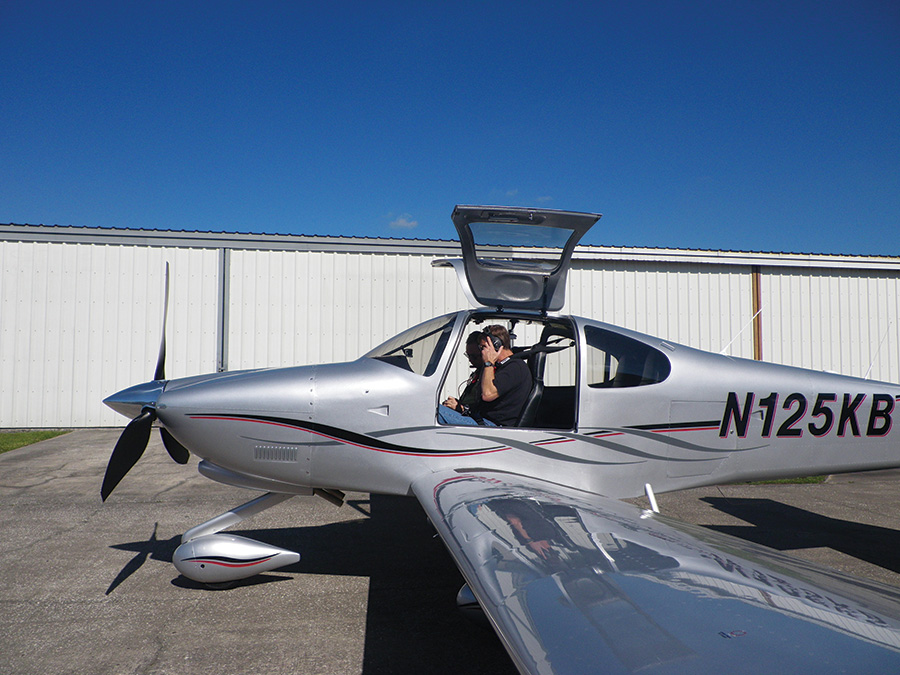
Making certain the intercom is working properly and the radios are tuned appropriately. Clear communications can really help alleviate any misunderstandings if things go awry.
I know—and have seen—that without it, there will be the rule-breakers who will not have a real Qualified Pilot in the cockpit. They will continue to contribute to the accident statistics. While this maiden flight went very well, I know a lot of it was stacked in my favor, and hence my decision to perform the role as a Qualified Pilot. (See the sidebar for details on my decision process.) Maiden flights are serious business, and doing everything you can to minimize the risk is important.
I became a DAR many years ago to help ensure that safe airplanes were put into the air. In this particular case, I was able to contribute past the inspection phase and help ensure a safe maiden flight. I think Bob’s wife Kathie said it quite well:
“Although I have great confidence in Bob’s abilities as a pilot and Experimental aircraft builder, I felt relieved when the new Additional Pilot Program allowed Vic to accompany Bob on the maiden flight. I think Vic’s broad experience in the RV-10 (1500 hours +) gave Bob an understanding of the characteristics of this aircraft during the initial flight that he couldn’t have achieved going solo, thus improving safety.”
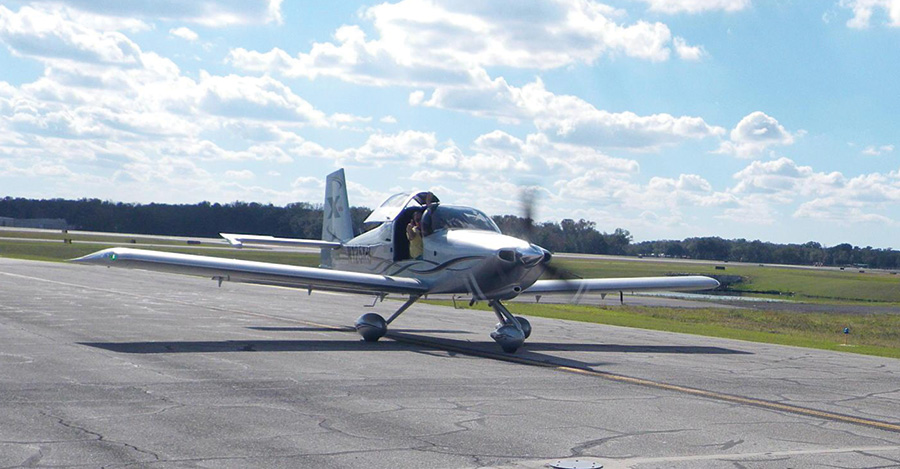
The weather was absolutely perfect for a first flight, especially when you need to run at high power settings for engine break-in. Winds were almost calm, with very few bumps and excellent visibility.

